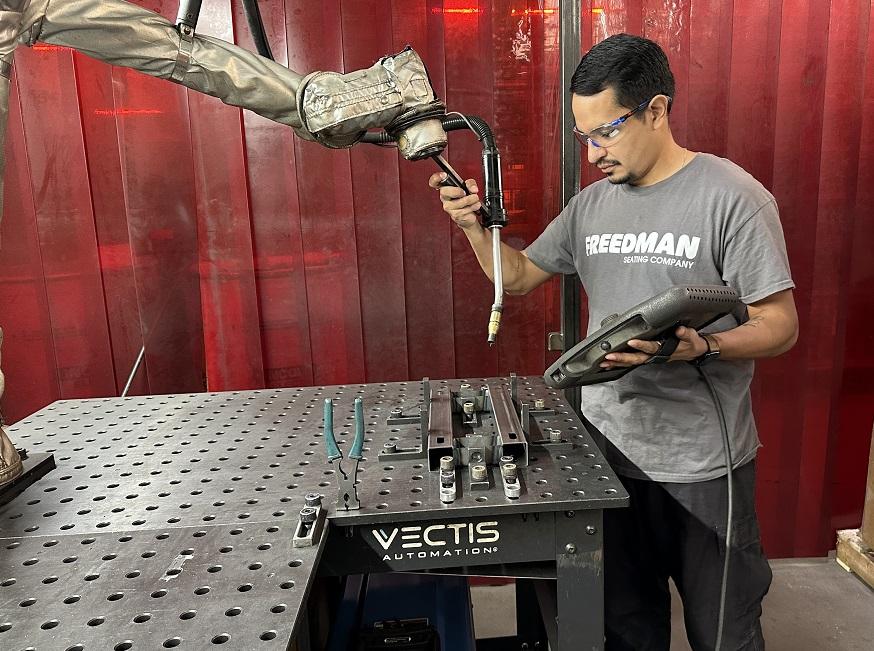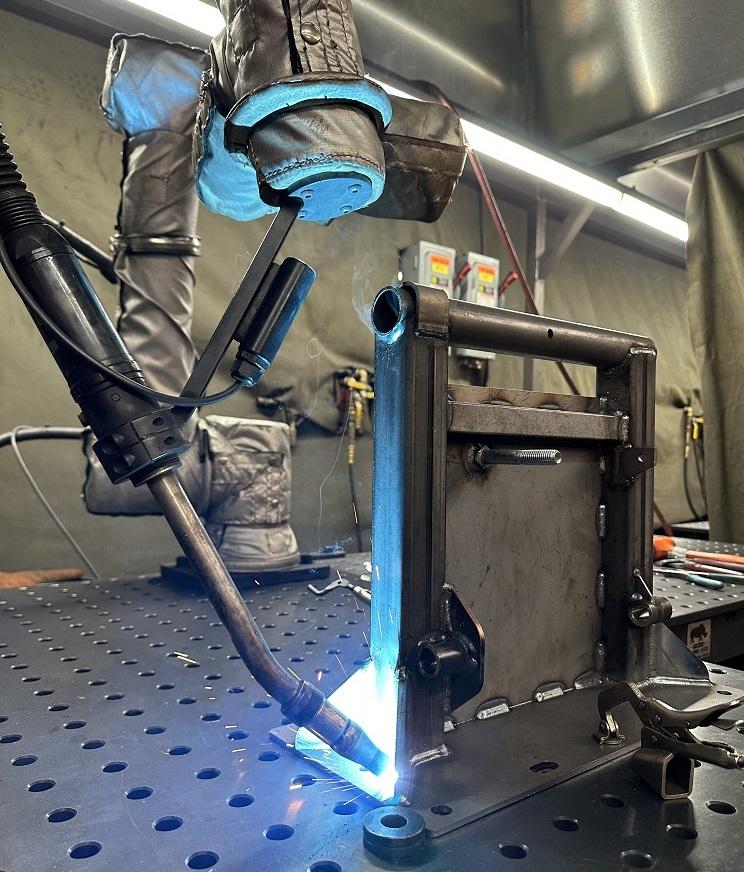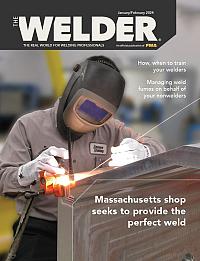Editor
- FMA
- The Fabricator
- FABTECH
- Canadian Metalworking
Categories
- Additive Manufacturing
- Aluminum Welding
- Arc Welding
- Assembly and Joining
- Automation and Robotics
- Bending and Forming
- Consumables
- Cutting and Weld Prep
- Electric Vehicles
- En Español
- Finishing
- Hydroforming
- Laser Cutting
- Laser Welding
- Machining
- Manufacturing Software
- Materials Handling
- Metals/Materials
- Oxyfuel Cutting
- Plasma Cutting
- Power Tools
- Punching and Other Holemaking
- Roll Forming
- Safety
- Sawing
- Shearing
- Shop Management
- Testing and Measuring
- Tube and Pipe Fabrication
- Tube and Pipe Production
- Waterjet Cutting
Industry Directory
Webcasts
Podcasts
FAB 40
Advertise
Subscribe
Account Login
Search
Welding cobots improving efficiency on the production floor
Metal fabrication shops share experiences with using cobots and other welding automation
- By Rafael Guerrero
- January 31, 2024
- Article
- Automation and Robotics

Marvin Herrera, one of the guest speakers at the conference, was instrumental in introducing cobots to Chicago-based Freedman Seating Co. Marvin Herrera
Welding automation is nothing new for Marvin Herrera and Corey Mays, as their jobs have incorporated it in some form or another for years. Their respective workplaces, Freedman Seating Co. and CM Welding & Machine, had traditional robotic cells in place.
Both companies have introduced cobots to their respective shop floors over the past few years. It was these experiences that brought them to Ohio State University last October for the American Welding Society’s Welding Automation Expo & Conference.
The three-day event featured presentations on how legacy manufacturers can rethink automation, the current and future state of welding, improving efficiency, and welding automation challenges and solutions. Multiple welding equipment and cobot manufacturers were on hand for demonstrations and information. Some attendees also visited Ohio State’s Mars G. Fontana Laboratories and the facilities of nearby Path Robotics and EWI.
Cobots have helped Freedman Seating Co. and CM Welding & Machine reduce or eliminate labor shortages and production bottlenecks—all while not being entirely difficult to master. But as Mays, Herrera, and others at the conference pointed out, these robotic systems still have limitations.
“Understand your application, understand that automation can assist and can help, but it won't solve all,” said Mays, the president of CM Welding & Machine, Midland, Texas.
The experiences they shared may have sounded familiar to some of the attendees that week. For others, though, it may have been eye opening.
Make a Seat
The introduction of welding cobots to Chicago-based Freedman was an opportunity for Herrera to make a name for himself within the company. He had risen from welder to welding engineer over a span of a few years.
Freedman—a family-owned company that’s been around for more than 125 years making seats for buses, RVs, and other modes of transportation—had also shown willingness to adopt and improve welding automation in its operations. Prior to 2019, Freedman had multiple Yaskawa Motoman traditional robotic cells in place. Freedman had found ways to improve efficiency, such as by reducing the number of cells and manual welders necessary to make a part. This decision led to a reduced part cycle time.
When Herrera was tasked with finding new technology that could improve speed, weld quality, and parts production, he gravitated toward cobots after attending FABTECH and learning more about them.
“I remember reading about them and I was like, ‘Oh, these cobots sound cool. It's something new. I haven't heard too much about them,’” he said.

The role of welding robots in metal manufacturing shops was among the topics of interest at the American Welding Society’s Welding Automation Expo & Conference last October. Marvin Herrera
The company president was into the idea of new technology, so the Freedman team gave Herrera the OK to invest in a cobot in 2020. This investment became even more urgent when the COVID-19 pandemic made a significant dent in the company’s workforce.
“At the end of 2020, he said to me, ‘How quickly can you get it in here?’” Herrera recalled. The company’s first cobot—from Vectis Automation—arrived just before the end of that year.
Herrera tasked the cobot with the production of a polished stainless steel transit seat—Freedman’s first automation project that involved stainless. Prior to cobots, Freedman’s traditional welding robots worked primarily on carbon steel. Some said it couldn’t be done, but Herrera believed in the cobot’s potential.
The cobot revealed new possibilities to Herrera, such as how to improve fixturing and how to make parts production more efficient.
“We had some fixtures where ... there were a lot of clamps in this fixture. It was two operations. They had to weld the bottom of the seat, take it out, flip it, and then weld the top seat or the top part of the seat, and it took a welder about 12 minutes to weld one seat,” he said. Fixturing improvements and the cobot’s ability to move from one welding table to another allowed them to make the part much quicker.
“And now we get one part every 3 ½ minutes. So about every seven minutes, we're getting two parts,” Herrera said—roughly a 200% productivity increase.
The cobot only works on this particular stainless steel seat. “We don't break the setup. It's just constantly running that same part,” he said.
Since then, Freedman has implemented two more cobots for use primarily on carbon steel parts for midsize vehicle seats. As the company adjusts to an increased demand for carbon steel seating, it has shifted some of the work away from traditional robots in favor of the cobots to alleviate the traditional robots’ workload, Herrera said.
For Freedman, welding automation has proven successful. But Herrera advised shops to do their research and make sure a cobot is the right fit for them. He suggests shops ask themselves: Do we have the space for a cobot? Are we producing high-volume parts? Is our shop ready for welding automation equipment?
“Traditional [robots] are always going to outrun cobots in welding times, but there’s a place and time for each. You need to weigh out what makes sense to you,” he said.

The second-ever Welding Automation Expo & Conference, held in Columbus, Ohio, featured guest presentations, booth demonstrations, tours, and networking opportunities to highlight welding automation in areas like cobot implementation. Rafael Guerrero
Manual welders are still needed, even in a more automated welding bay, Herrera added. In fact, cobots and industrial welding robots may motivate employees to tap into their own potential. Two cobot operators he trained used to work in materials handling, but now they are in welding school learning to become better welders.
“I'm sure you have people out there on the floor that are trainable, coachable—you want to pinpoint them,” he said.
“You don’t want them to be scared or fearing the cobot is taking jobs,” he continued. “I think we did a good job because a lot of them noticed that cobots would alleviate some of their stress, their pains, and they could see the benefits.”
Final Frontier
CM Welding & Machine primarily focuses on modular oil and gas facilities, fabricating parts for prefab vessels, tanks, piping, and support structures. Mays calls his line of work the “final frontier” for welding automation.
To maximize welding automation output, Mays said “we have to start with the people. We have to understand that in order to get the most out of our automation, we’ve got to establish a culture that is accepting of automation and views automation as a tool and not a threat or hindrance.”
Mays believes his business has done well to establish such a culture. Its in-house training and apprenticeship programs have employees involved in all aspects of manufacturing, including cobot operation. They walk a fine line, he said: He wants them learning how to operate a cobot while also improving their welding skills.
“We don’t want their automaton techniques and training dependent on their welding training. We want them to develop these two simultaneously,” Mays said.
The Texas business already had industrial welding robots in place prior to 2019. Cobot adoption was never the goal, Mays said—the company just stumbled into it.
Like others, Mays was looking to find technology to address the problems his company’s traditional robots could not solve. In this case, he wanted to simplify short-batch runs and decrease setup time.
“The way we treat traditional robotic setup is similar to setting up a CNC mill or 5-axis job,” Mays said. “It really works well if you have a high-volume type of order. But if you have a high-mix, high-volume order where you have a lot of parts, but a lot of your features and dimensions and characteristics of those parts change every 10 or 15 or 20 or so parts—and you’re using traditional robotics to attack that problem—you add a lot of setup time.
“If the arc is not lit, you’re not making money. You’re burning up a lot of hours on setups and breaking things down and changing fixtures.”
Cobots were attractive to Mays for a number of reasons. The open-cell capabilities allowed his employees to work alongside the machine. The learning curve is short, and setup time and programming can be done within hours of unboxing the cobot. Shops can integrate fabricated fixturing to a cobot system, speeding up setup time as a result. Mays said setup time is at least 20% faster using a cobot cell versus a traditional robot cell. Cobot software can be updated. It’s portable, allowing employees to simply move the cobot to the parts that need to be processed.
“You’re up and rolling versus a conventional type of situation, where you'll be doing some machining, locating pins and heavy fixturing and things like that,” he said.
A cobot cell provided the company with the flexibility to assist the traditional robots, which run two to three parts and that’s it, Mays said.
“Given all that automation upstream, we had quite a bit of bottlenecks created because we needed a solution that was a little bit more flexible than our traditional robotic cell—and that’s where the cobot comes into play,” he added.
But those who think a cobot will solve all of their problems should think again. Mays said he’s consulted people who believed welding automation would immediately solve all their problems, only to find out that new problems arose.
Automation has limitations, and each type of system has its advantages and disadvantages.
“Collaborative robotics and conventional [robots], they both have their uses,” Mays said. “I'm not saying one is better than the other. Cobots work better for a lot of fab-type assemblies versus high-volume, 200-, 300-, 400-, 1,000-part [situations]. I would try to attack that type of job with conventional robotics before doing it with collaborative.
“If you don’t understand what the equipment can do, you'll probably run into a lot of problems down the road,” he added.
CM Welding & Machine commissioned its second cobot this past fall, and Mays said the company plans to implement another in early 2024, with plans to add a plasma cutting cobot in the works.
About the Author

Rafael Guerrero
2135 Point Blvd.
Elgin, IL 60123
(815)-227-8242
Rafael Guerrero. was named editor of The Welder in April 2022. He spent nine years as a journalist in newspapers in the Midwest and Pacific Northwest, covering topics and communities in central Illinois, Washington, and the Chicago area.
About the Publication
Related Companies
subscribe now

The Welder, formerly known as Practical Welding Today, is a showcase of the real people who make the products we use and work with every day. This magazine has served the welding community in North America well for more than 20 years.
start your free subscription- Stay connected from anywhere

Easily access valuable industry resources now with full access to the digital edition of The Fabricator.

Easily access valuable industry resources now with full access to the digital edition of The Welder.

Easily access valuable industry resources now with full access to the digital edition of The Tube and Pipe Journal.
- Podcasting
- Podcast:
- The Fabricator Podcast
- Published:
- 04/16/2024
- Running Time:
- 63:29
In this episode of The Fabricator Podcast, Caleb Chamberlain, co-founder and CEO of OSH Cut, discusses his company’s...
- Trending Articles
Sheffield Forgemasters makes global leap in welding technology

ESAB unveils Texas facility renovation

Engine-driven welding machines include integrated air compressors

How welders can stay safe during grinding

The impact of sine and square waves in aluminum AC welding, Part I

- Industry Events
16th Annual Safety Conference
- April 30 - May 1, 2024
- Elgin,
Pipe and Tube Conference
- May 21 - 22, 2024
- Omaha, NE
World-Class Roll Forming Workshop
- June 5 - 6, 2024
- Louisville, KY
Advanced Laser Application Workshop
- June 25 - 27, 2024
- Novi, MI


























